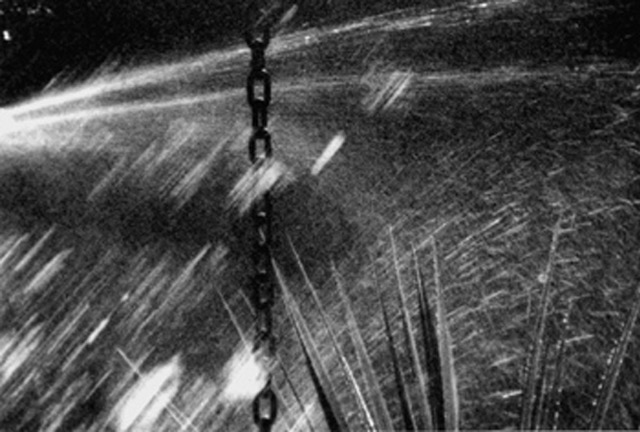The beloved filmmaker and SUNY Binghamton professor Vincent Grenier, who died last November at 75, was an unassuming and affable presence in the avant-garde film world. His quiet modesty belied the fact that he was also one of the form’s greatest artists. Today’s tribute program at Anthology Film Archives proves the case with fourteen rigorous, beautiful, and deceptively simple short films (16mm and digital) made between 1975 and 2021. Grenier was trained as a painter and his work is deeply rooted in the physical world, with particular sensitivity to color, light, and geometric form. But his genius lies in his ability to translate his vision of the world into purely cinematic experiences that honor the flatness and rectangular shape of the screen, in his dexterity moving fluidly between abstraction and representation, and in the nonstop inventiveness he achieves with such limited means.
To make Watercolor (Fall Creek) (2013), Grenier trained his camera on the flowing water in a shallow creek under an expressway and rail bridge. The entire screen is activated with a rich array of variations in texture, reflections of people, clouds, and buildings, as well as the subtle play of color, shadow, shapes, and figures, all of which is accompanied by a carefully orchestrated soundtrack mixing animal and traffic sounds. Like much of Grenier’s work, the film is lushly beautiful, a sensual pleasure for the viewer to enjoy while doing the cerebral work of comprehending the film’s formal play.
The earliest films in the program, Interieur Interior (1975) and Light Shaft (1975), are about as minimal as minimalism can get. In the former, a vertical black line that at first appears to be an emulsion scratch in the film but turns out to be a light cord, is among the very few variations in an otherwise almost entirely monotone gray screen. Shapes gradually shift and optical illusions are revealed; the same happens with the triangle of light that appears to move diagonally across the screen (or is it the camera that’s moving?) in Light Shaft. In both films, Grenier expands our consciousness while limiting our scope of view.
Grenier introduced the element of storytelling into his films with the poetic documentaries You (1990), Out in the Garden (1991) and Tabula Rasa (1993-2004); we hear from a young woman recounting past dates with a man who couldn’t control his anger, from a friend of Grenier’s who talks about his recent HIV diagnosis, and then from students and teachers in an old high school building. In each of these films, the testimony is asynchronous with the imagery, allowing for free association and counterpoint.
No synopsis can truly capture the depths of the artistic adventure in a Grenier film. Waiting Room (2012), filmed by Grenier during a visit with his son to a pediatrician’s office, is rich in its observation of human behavior and even stronger as a Rothko-worthy study of the striations of fluorescent light as recorded by a video camera. And Armoire (filmed in four parts, from 2007-2011), structured around the reflection of a robin’s flight in a mirror, is a cubist extravaganza that sees the shape of the frame constantly change to contain the bird in motion.
Grenier exemplifies the type of filmmaker that the scholar and historian Tom Gunning had in mind when he wrote the 1989 essay “Towards a Minor Cinema.” Following what could be called the heroic period in avant-garde film, with conceptually ambitious work by such larger-than-life personalities as Stan Brakhage, Hollis Frampton, and Michael Snow, Gunning praised contemporaneous filmmakers who worked in a smaller register while still creating revelatory and exciting work. The “Minor cinema” that Gunning is celebrating “begins by expressing itself and doesn’t conceptualize until after.” Grenier, then, can be viewed as one of the great masters of minor cinema.
The Vincent Grenier Tribute takes place this afternoon, November 16, at Anthology Film Archives.



